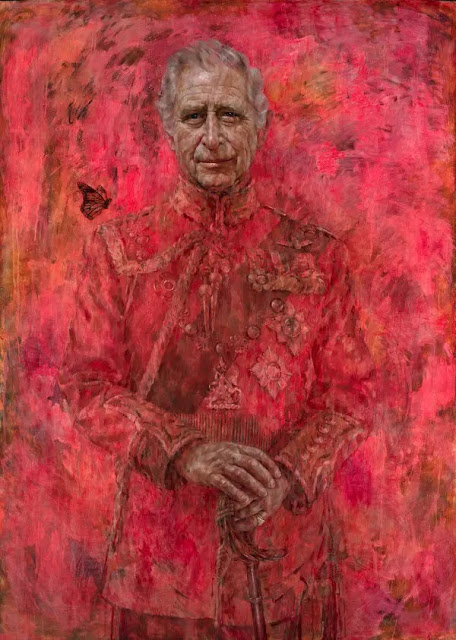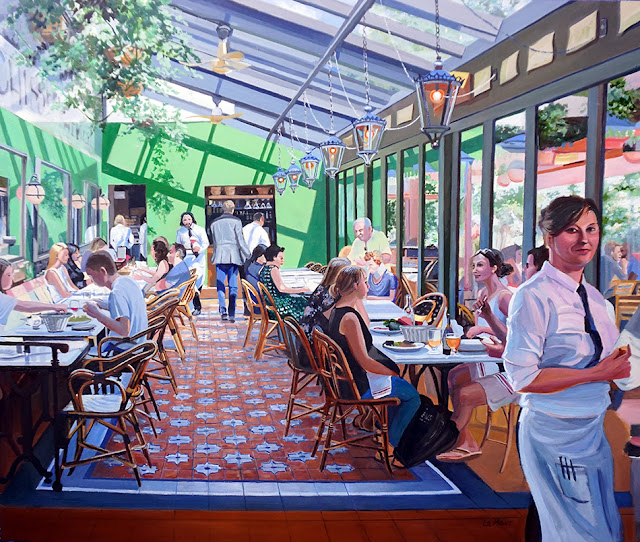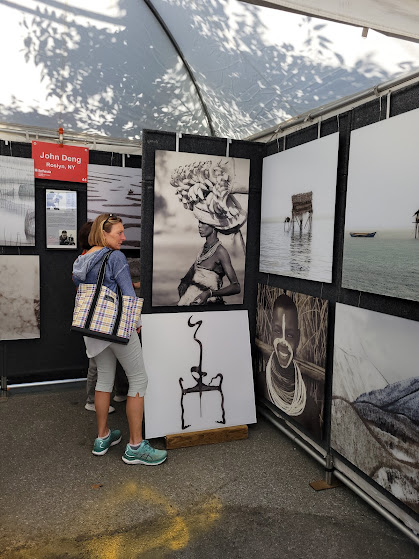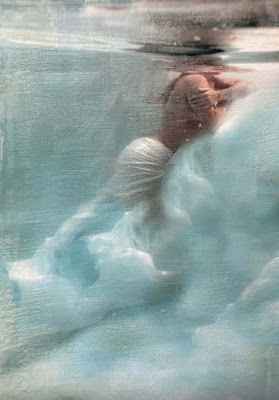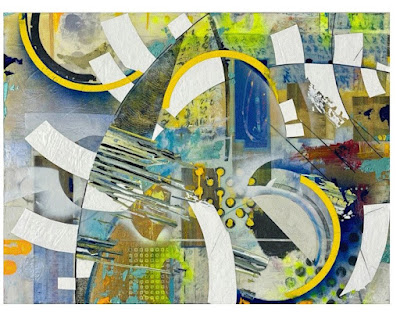I first published this over a decade ago, in two parts, and it has been completely ignored by all the art and artists' organizations to which it was aimed... here's the gist of it and I've refreshed it a little, updated it, and combined the two parts:
Let us start...
Over the last two decades, I've written many times before about art fairs and Art Basel Miami Beach week in the Greater Miami area - this is the world's "big dance" when it comes to the visual arts; this is the big party and everyone is invited. However, it is a matter of how to get into a reputable art fair that's the issue to many artists and galleries.
Art fairs are very expensive. As I've noted before, many galleries risk everything to come to Miami or New York, or London to do an art fair, and I suspect that many are financially destroyed at the end of the week. And yet, many do well and return year after year.
Between my years with the Fraser Gallery and now with AAAP, we've been returning to Miami for two decades now. Other DMV and regional galleries that keep coming back are my good buds at Connersmith, sometimes also Hamiltonian. They consistently take the financial risk and venture to Miami (and in some cases all over the US and Europe). Some other participants have been Morton Fine Arts, Zenith, and Adah Rose.
Others have tried a year or two, crashed and burned and never return to the party.
Is there a formula to this? What the the magic that makes this work for some and not for others?
I know of at least two galleries in the Mid Atlantic who have "financial backers" who absorb most or some of the financial risk involved in doing an art fair. Since these sort of galleries are very limited (who wouldn't love to have a financial backer?), they are the "outliers" in the formula for clicking the right button in the art fair game.
Some non-profits have the economic stability to play consistently in the art fair game; and to make it easier for them, many art fairs have special, lower pricing for non-profits. So they are also a special case, I think, because in most cases, the financial risk is absorbed by the state of their income-gathering to stay afloat as a non-profit.
It is a mystery to me why not more DMV area non-profits go to the art fairs. Hamiltonian is a notable exception, as has been Honfleur Gallery in Anacostia.
And the WPA did use to participate in the DC-based and fabled (e)merge art fair... and it did really well!
But I would submit that there are several area non-profits that could, and should participate in Miami and New York art fairs as part of their business model; if a local non-profit can afford to pay $70-$80,000 a year to its executive director (and several DMV non-profits are in that range), then it can certainly afford to budget $12-18K to participate in an art fair outside of the DMV.
I think this as an outsider - completely ignorant to the money shell game that running a non profit must be, and I tip my hat to them.
I'm not saying that all visual arts non-profits should do this - I am sure that the mission of some of them are strictly focused on "local" only, rather than expanding their artistic presentations outside the capital region.
But that still leaves several key ones that (if I was the DMV art dictator) should be in NYC and Miami during art fair times.
This also applies to some of our large membership-based visual arts organizations and cooperative galleries, such as The Art League.
I'm a big fan of The Art League, and when I lived close to Alexandria I was a member for many years, and I have been honored multiple times by being selected as a juror for them.
And thus I am going to use them as an example, but this example applies to the multiple "other" art leagues, groups, clubs, cooperatives, etc. that exist around our region and which are important and significant components of our cultural tapestry. I could just as easily have picked the Rockville Art League, or the League of Reston Artists, or Tephra ICA, Waverly, WPA, Touchstone, Fairfax Art League, CHAW, etc.
The money part is always an issue, but when the money risk can be divided into several (rather than one) entities, then the overall financial risk is reduced, because it is spread, rather than concentrated into one (the independent commercial gallery) bank account.
So let's proceed with this possible example using The Art League.
They have several thousand members and run a very successful and important program in their space inside the Torpedo Factory and assorted classrooms all over the area. So successful in fact, that changing that model (or expanding it...) must seem anathema to their leaders.
So the issue is, how does The Art League (again, you can fill in any of multiple DMV area membership-based art organizations) pick or select the 3-5 artists to take to an art fair?
The "good" art fairs are nearly always tightly juried. There are many art fairs where one just pays and anyone and everyone can go - those usually suck as some DMV galleries and many DMV solo artists will unfortunately discover when they suddenly decide to jump into the art fair arena of without research.
And thus for Miami/NYC fairs I am thinking (in no particular order) about Art Miami, Context, Aqua, Pulse, NADA, Untitled, Volta, Affordable Art Fair(s), Scope, Miami Project, Frieze... some of these are very, very hard to get in, but they're listed nonetheless, because there is a "food chain" of art fairs, and the bottom-feeders usually spell disaster for the participants.
And thus The Art League would need to establish a process to pre-jury its membership to 3-5 artists and apply with those artists to an art fair. I would start with The Affordable Art Fair in New York. They are close by and they are a "proven" fair which has been in operations over 25 years. I have done it many times and consistently recommend it to any gallery that asks me about art fairs in general.
And thus The Art League would need to canvas their membership and find out who is interested in being juried for possible selection for further jurying into an art fair. I would make this process independent from the Art League itself - just like they do for their monthly juried shows, and have interested artists bring their work in to be juried by an independent juror.
That juror has to be a very special juror - in fact 98% of your standard-issue visual art jurors (art professors, art critics, art writers, art center directors, artists, etc.) would guarantee a disaster to this process. In the DMV the jury pool for this process is very limited and its members are only those gallerists who have participated in multiple art fairs. In fact I can't think of anyone better to jury this part than me! Or Leigh Conner or Adah Rose...
This is a critical point, so I'm going to repeat it: The DMV the jury pool for this process is very limited and its members are only those gallerists who have successfully participated in multiple art fairs. In fact I can't think of anyone better to jury this part than me!
Let me repeat another key point: The Art League would need to canvas their membership and find out who's interested in being juried for possible selection for further jurying into an art fair.
Everything that I'm going to discuss below has to be clearly explained in the prospectus for this process, so that each applying artist knows exactly what this would involve.
I suspect that a large number of artists would find this attractive, and perhaps a small jurying fee ($10?) could be applied to subsidize the art fair costs (I would budget anywhere from $12-20K, depending on booth size).
Whatever you do, DO NOT use an art fair director as a juror! They are usually interested in what would make the fair look good (usually from an unsellable trendy perspective) , rather than understand the delicate balance of good art, finances, and peripheral issues that come to play into this process.
The juror would pick 3-5 artists and 2-3 alternates. This is because some art fair processes do have the option to accept an application while at the same time rejecting some of the artists in that application.
So now we have a group of artists, culled from applying Art League members, ready and willing to participate in an art fair.
The actual application process is easy, so I'm not getting into that - be aware that deadlines are usually months before the actual fairs.
If accepted, the next step is transporting the artwork to the art fair, and then returning the unsold artwork back to the owners. For this, the Art League has various options.
One option would be to hire a transport company. There are dozens and dozens of specialized carriers that do this and they pick up and transport the art to your booth at the fair, and at the end pick it up from your booth and transport it back. This is the easiest and the most expensive. From here to NYC and back I would budget $1200-$2000 depending on volume. Packaging also becomes an issue here.
Another option is to rent a truck or van and schlep the work to and from the fair yourself. This is what I usually do for New York and Miami.
A third option is to have each artist (or teamed artists) bring their own work in their own cars, vans, etc.
In this example, I would offer each accepted artist the choice to come to the fair, and help hang and help to sell their own work. This should be an option, not a requirement, as some artists would rather spend a week in Baghdad than a long weekend in an art fair dealing with art collectors; but some artists do like doing that. In any event, just "being" and seeing what goes on at an art fair is a spectacular learning opportunity for anyone involved in the visual arts.
The Art League has the luxury of having a very skilled "front desk" team that is already well-versed in the arcane art of selling artwork - so they could and should also come to the fair to handle questions and sales, etc. DO NOT send your executive director or curator to handle sales - that would be a disaster!
We're getting dangerously close to having a lot of people crowding the booth, so let's please keep the number of people hanging around the booth at all times to less than three; the artists can "float" in and out.
There is strength in numbers in many other aspects: transporting artwork, hanging it, packing it, splitting costs of hotel rooms, etc.
Before you book a hotel room anywhere in the major US cities (especially NYC) always check www.bedbugregistry.com. Again, I kid thee not. Pick a hotel that is walking distance from the fair or public transportation to the fair.
The elephant in the room here is cost(s), but again there is strength in numbers.
Art fairs often offer discounted prices to non-profits; Honfleur Gallery in Anacostia (in the past) has participated in The Affordable Art Fair in NYC and takes advantage of this special pricing. WPA participated (and had great success) at (e)merge and Hamiltonian is often somewhere in Miami.
Art fair prices are different depending on the fair. You can see the booth prices for the next Affordable Art Fair New York here.
I'm my head I have this concept of having the selected Art League artists have a "financial stake" in this process by having them contribute some funds towards the art fair fees. Nothing works like putting your money where your mouth is. But then again, as a large organization, perhaps a more artist-friendly model would be for the Art League to cover all the art fair costs from a combination of jury entry fees and their own budget.
Of course, the Art League would also keep their usual commission on sales, so this also has a money-making angle for them.
What are the art fair costs? There are direct costs and associated costs.
Direct costs are:
(a) Cost of the basic booth
(b) Cost of additional booth stuff (extra walls, extra lights, storage)
(c) Some fairs have a "shared" advertising cost (AAFNYC doesn't)
Associated Costs are:
(a) Cost of required insurance (Art League would be able to use their current insurer or buy insurance directly from the art fair)
(b) Cost of transportation of the art. If using own vehicle, then also cost of parking it
(c) Cost of Art League staff at the fair (bus to NYC and shared hotel room and per diem for food)
(d) Cost of the juror to select the artists
Funding sources for all these costs are:
(a) Art League budget
(b) Nominal jurying fee for applying artists
(c) Commission on sales at the fair (this, of course, is putting the cart ahead of the horse)
Commercial galleries take huge chances at art fairs. My very first art fair all around cost was about $8,000 almost two decade ago - all that was charged on the gallery's credit card and we held our breath while at the fair. We sold about $30,000 worth of art, and thus after commissions to the artists we cleared $15,000 and paid off the credit card and then had $6,000 to put towards the next art fair fee.
I can count on one hand the number of times that we sold that much in any gallery art show in the DMV; and I've had a gallery here of one sort or another since 1996.
What's in it for the artists?
Usually a lot more than for the gallery. I will repeat this: more often than not, an artist reaps more good things out of an art fair than the gallery does.
These things include:
(a) Exposure to more art collectors, curators, press, etc. in a few days than in years of exhibiting art around the DMV. You will see more people in 4-5 days than in five hundred years at a gallery in the DMV. Statistically (and yes I do have an undergraduate Math degree in Numerical Analysis in addition to my Art degree), the sheer number translates into sales. Since my first art fair in 2006, I have sold over 500 works of my art.
(b) Exposure to other galleries who may be interested in your work. I have multiple examples of this - Just ask DMV area artist Judith Peck what has happened to her career once she started showing at art fairs.... or read the example of my dear friend Sam Gilliam!
(c) A significantly higher chance of getting critical press.
(d) A significantly higher chance of getting your work noticed by both freelance and museum curators and art advisors, etc. Since 2006 I've had over twenty commissions via art advisors and several pieces acquired by multiple museums. The chance of getting your work noticed by a DMV museum curator is probably higher than the chance of winning the lottery. Most DMV area museum curators (AU's Jack Rasmussen being the brilliant exception) would rather take a cab to Dulles to fly to Miami to see emerging artists' works at fairs than taking a cab to see a gallery show in Georgetown.
(e) Being part of the art fair "wake effect" --- Read about that here.
(f) A much better chance to getting invited to participate in other shows such as university shows, themed-shows, group shows, etc. Ask Virginia artist Sheila Giolitti about that.
I hope that I've made my point, and I hope that some visual art groups and organizations are reading this.
WPA, Tephra ICA, Blackrock Center for the Arts, Touchstone, Art League, Washington Project for the Arts, Maryland Art Place, Multiple Exposures, Gallery 10, Washington Sculptors Group, VizArts, Artomatic, Waverly Street Gallery, DC Arts Center, DCCAH, Target Gallery, Torpedo Factory, Montgomery Art Association, Workhouse Arts Center, Art Gallery of Potomac, Rockville Art League, The Artists' Undertaking, Glen Echo... I'm looking at you.
UPDATE: Cristina Salmastrelli, the energetic Regional Managing Director for Ramsay Fairs, pipes in with some terrific comments:
My comments, in no particular order:
I love that artists should not be required to come to an art fair if they do not want to. There are some artists that cannot stomach the fast pace of a fair or the harsh realities that comes with it. This is why artist representatives are so important, in my opinion. Visitors and potential art buyers can be quite harsh and sometimes artist cannot hear negative feedback. I never want an artist to hear negative feedback unless it’s filtered through their representation or a proper lense. In my opinion and in the most idyllic sense, the entire gallery system is there to protect the artist and their creativity from external messages. I have seen artist wilt when representing their own work and that makes me really upset, so I love the fact that the artist onsite requirement theory can be eliminated.
The formula for art fair success is an ever changing one. It more and more reminds me of early motherhood or Instagram’s algorithms every day. Once you feel like you got your system down pat, CURVEBALL STRAIGHT AHEAD! And the only way to properly prepare for this is to come in feeling strong and excited to talk to people at every opportunity. Every edition needs to be your first and there can be no assumptions that you will be as successful as your last. And with that theory, the fair experience never ends on the last day and that constant follow up and dedication to build relations with new clients, old clients and potential ones will pay off down the line.
It never hurts to take time to try and understand the different motivations when it comes to purchasing art. From there, take time to practice how to close deals based on the variety of reasons why someone buys an artwork. In the end, this exchange is about emotions and this purchase is emotive, so understanding people really helps to make your experience a successful one.








